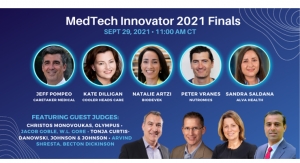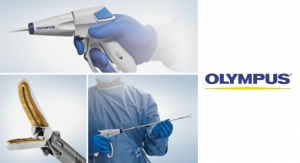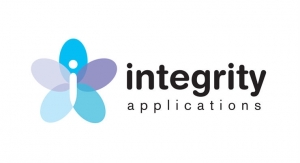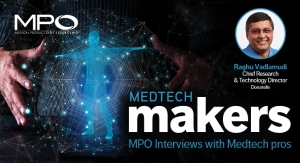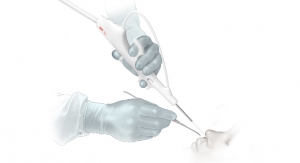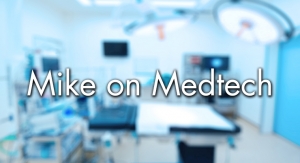Ken Olewiler, Founder and Managing Director of Punchcut06.01.20
Medical product and device manufacturers are facing new design and delivery challenges in the era of COVID. Unexpectedly, there have been massive spikes in demand for products, as medical communities and end-users scramble to purchase products and parts that are suddenly in short supply. Similarly, physical workflows and usage scenarios have been thrown into disarray due to social distancing measures. These issues have forced medtech and device manufacturers to improvise and be incredibly nimble to deliver efficient, flexible products, and services. How can they possibly decide which changes they should make immediately to ensure their systems, which are being pushed to the max, won’t break when they’re needed the most? At the same time, how can they think ahead and scale their businesses for the future so they are prepared for whatever new market conditions lie in wait just over the horizon?
The answer is Design Acceleration. Design Acceleration applies systematic design thinking in nimble ways to help companies adapt in times of crisis or high demand.
Step One: Listen First
Start by listening for problems. Don’t move into solutions right away. Listen to users. Focus on people, not just products. Every product, no matter how big or small, has a user experience attached to it. Listen to those users.
To illustrate, here’s one way we’ve gathered feedback via a series of interviews. When Fitbit began moving from a fitness-based device into healthcare and chronic condition management, we partnered with their team to figure out how to best communicate sensitive medical information about potential health issues to current and prospective users. We knew that the best way to get to the bottom of this would be to speak with a set of folks with related health risks and conditions, in addition to their medical providers. We quickly assembled a UX research team to conduct secondary research, along with exploratory user research through in-home patient interviews and a few subject-matter expert interviews with specializations in sleep medicine, pulmonology and neurology. Our goal was to hear their patient journey stories—from detection and screening to diagnosis to treatment and management—and observe their behavior as they self-monitored, assessed, and communicated with their clinicians. The insights we gleaned from interviews provided some surprising findings that ran counter to traditional assumptions which helped us form clear and actionable steps for Fitbit to best support patients’ health needs and challenges given their specific conditions and risks.
Of course, if you’re moving fast, you don’t have time for a four-month in-depth study, or even a six-week study as in the Fitbit example. But you can scan social feeds for expressions of need, likes, dislikes or just as quickly and easily ask a handful of end-users via a short survey, or directly via a quick impromptu user group. You don’t have to wait to have the perfect sample size, or the perfect amount of feedback. Even a sample size of one is better than none, so get going. Whatever you do, do not skip this all-important step.
Step Two: Think Big
After listening for problems, map out some of the insights you heard that you think are most critical. Pick a problem you think you can probably address—a broken workflow, a supply dearth, redesigning a part or device for a different use case—try to zoom out a bit to put yourself in the shoes of one person facing that problem. What does that person’s whole journey look like, beyond their use of the product or service in question. What does his or her week, month, year look like? What ripple effects will emerge if you make the changes you’re debating making? Only after you’ve thought about the whole journey can you move on to the next step of envisioning potential solutions.
This is the time to think big and be creative. Even though you may know the challenges of a problem, don’t let them be limitations to your ideation phase. Avoid directly translating what you heard from an individual during research into a solution because users don’t communicate solutions—they communicate problems. Instead, draw from the insights of everyone you heard from and dare to go beyond the traditional constraints that may ordinarily discourage you from coming up with big (and even wild!) ideas. This takes shape by brainstorming, ideally with a cross/multi-disciplinary team that can bring different specializations and perspectives. Map out user journeys and experiences and then envision potential solutions by sketching out your ideas and collaboratively workshopping them. Identify the key areas for improvement or opportunity and figure out how you might address them.
We worked with an e-commerce company that boldly wanted to expand their offerings into new services to enable their customers to achieve better health in areas of primary care, mental health, nutrition and physical fitness. After generative research, we helped them move beyond typical product considerations and look at the overall journey of how people monitor, manage and motivate behaviors for ongoing health and wellness. Through the process of reviewing the patient-practitioner relationship, we identified and mapped out the universal phases in any treatment approach. Through analysis of the conversations with subject matter experts and exploration of behavior change methods, several common techniques and approaches surfaced. The results of this overview provided strong evidence that changes to existing systems would be myopic - thinking bigger we suggested a whole new health services model that could reach customers where they are in their own health journey, and provide them with the tools and support most likely to empower them to change unhealthy behaviors. This big thinking provided a framework for how the company's new products and services could fit into this life cycle to provide the most value, which enabled business units within the organization to begin envisioning solutions best aligned to meet patient needs.
Step Three: Think small
Once you have mapped out the user journey and envisioned potential solutions, you may now have multiple areas of opportunity in front of you. To address the onslaught of potential problems that are just begging to be addressed, it can be tempting to think your team can quickly tackle several of these problems at once. Don’t. Choose to address just one problem that a) has the potential to have the greatest positive impact, and b) is achievable within whatever constraints you’re facing. Focus on a signature experience, something you identify as being unique to the company brand or product that has the most opportunity for growth and can bring the most value. If you focus on getting a key signature experience area right it will strengthen the offering and allow you to move more quickly. Yes, there will always be more that can be done. But fight the urge to boil the ocean. Design is about focus and quality. Thinking small then becomes all about the details. Design is working to get those details right.
Here’s an example to illustrate. We worked with Ancestry to expand their product offering in the health category and become a trusted market resource. While this business goal entailed an array of challenges, we concentrated on identifying one main problem that could yield the most impact: designing a solution to communicate complicated health reports and DNA results in a simple way yet still abides by strict guidelines and regulations. To avoid getting bogged down with an attempt to modernize the U.S. regulatory framework, we instead focused on coming up with a different digital health user experience—one that delivers clean, accessible, and digestible data. For example, rather than issuing typical medical questionnaires and forms, we replaced them with fun, one-at-a time interactive cards. The approach to educating users on genetic science was simplified to a Q&A style and high-level headlines (with the option to deep dive in the nitty gritty details) rather than extensive reports. Genetic conditions, hereditary information, and scientific concepts were explained through engaging visuals, which included interactive animation and illustrations, rather than plain text. By focusing on this one signature experience, we helped provide their consumers with health guidance and support where it mattered most.
Step Four: Think Big Again
Figure out how your innovation can scale to support the most scenarios—now or in the future. You don’t need to write a tome, because when you’re running in a crisis, you don’t have time to plan everything out. But you do have time to just think about what your roadmap may look like. Think about how this design change will impact one person and what their roadmap may look like and think about how you can scale to support more variations of that user scenario. Think also about how the design changes will fit into your business roadmap and viability. Are there new revenue streams? Are there new services? Design is a cycle that never ends—design is a means to increase value for people and businesses. Recognize that products today may need to change and evolve. Test in light ways to make sure that it’s working by listening to your users as you work on the rest of your roadmap.
We worked with GE Healthcare to redesign their electronic medical record and universal imaging experiences. We helped to develop and apply a comprehensive design system to accelerate product creation across the entire business by researching and designing the mobile experience for GE’s popular Centricity Electronic Medical Record product. One of their main objectives for partnering with us was to create a robust, scalable design system with an extensible framework, enabling future product design and development at scale. We built an app that could be shared widely to demonstrate design improvements from the start, but we thought ahead and included templates and components intended to transcend to other devices, including the Centricity Universal Viewer Medical Imaging Platform which we later redesigned to help radiologists and clinicians with diagnostics and patient care.
In these uncertain times, when traditional product and service innovation and delivery cycles have been flipped on their heads, it’s tempting to think there’s no time waste on design principles. On the contrary, times of crisis and flux make design principles more important than ever. By applying the Design Acceleration steps above as a truncated version of design processes, companies can successfully pivot immediately to enable rapid innovation and meet pressing needs, while still thinking ahead to what their products and businesses will need to look like down the road when ‘new normals’ settle in.
Ken Olewiler is the principal and managing director at Punchcut, a product design agency that accelerates design for the world's top companies. Olewiler has consumer expertise in digital health: wearables, medical devices, healthcare services, and tools.
The answer is Design Acceleration. Design Acceleration applies systematic design thinking in nimble ways to help companies adapt in times of crisis or high demand.
Step One: Listen First
Start by listening for problems. Don’t move into solutions right away. Listen to users. Focus on people, not just products. Every product, no matter how big or small, has a user experience attached to it. Listen to those users.
To illustrate, here’s one way we’ve gathered feedback via a series of interviews. When Fitbit began moving from a fitness-based device into healthcare and chronic condition management, we partnered with their team to figure out how to best communicate sensitive medical information about potential health issues to current and prospective users. We knew that the best way to get to the bottom of this would be to speak with a set of folks with related health risks and conditions, in addition to their medical providers. We quickly assembled a UX research team to conduct secondary research, along with exploratory user research through in-home patient interviews and a few subject-matter expert interviews with specializations in sleep medicine, pulmonology and neurology. Our goal was to hear their patient journey stories—from detection and screening to diagnosis to treatment and management—and observe their behavior as they self-monitored, assessed, and communicated with their clinicians. The insights we gleaned from interviews provided some surprising findings that ran counter to traditional assumptions which helped us form clear and actionable steps for Fitbit to best support patients’ health needs and challenges given their specific conditions and risks.
Of course, if you’re moving fast, you don’t have time for a four-month in-depth study, or even a six-week study as in the Fitbit example. But you can scan social feeds for expressions of need, likes, dislikes or just as quickly and easily ask a handful of end-users via a short survey, or directly via a quick impromptu user group. You don’t have to wait to have the perfect sample size, or the perfect amount of feedback. Even a sample size of one is better than none, so get going. Whatever you do, do not skip this all-important step.
Step Two: Think Big
After listening for problems, map out some of the insights you heard that you think are most critical. Pick a problem you think you can probably address—a broken workflow, a supply dearth, redesigning a part or device for a different use case—try to zoom out a bit to put yourself in the shoes of one person facing that problem. What does that person’s whole journey look like, beyond their use of the product or service in question. What does his or her week, month, year look like? What ripple effects will emerge if you make the changes you’re debating making? Only after you’ve thought about the whole journey can you move on to the next step of envisioning potential solutions.
This is the time to think big and be creative. Even though you may know the challenges of a problem, don’t let them be limitations to your ideation phase. Avoid directly translating what you heard from an individual during research into a solution because users don’t communicate solutions—they communicate problems. Instead, draw from the insights of everyone you heard from and dare to go beyond the traditional constraints that may ordinarily discourage you from coming up with big (and even wild!) ideas. This takes shape by brainstorming, ideally with a cross/multi-disciplinary team that can bring different specializations and perspectives. Map out user journeys and experiences and then envision potential solutions by sketching out your ideas and collaboratively workshopping them. Identify the key areas for improvement or opportunity and figure out how you might address them.
We worked with an e-commerce company that boldly wanted to expand their offerings into new services to enable their customers to achieve better health in areas of primary care, mental health, nutrition and physical fitness. After generative research, we helped them move beyond typical product considerations and look at the overall journey of how people monitor, manage and motivate behaviors for ongoing health and wellness. Through the process of reviewing the patient-practitioner relationship, we identified and mapped out the universal phases in any treatment approach. Through analysis of the conversations with subject matter experts and exploration of behavior change methods, several common techniques and approaches surfaced. The results of this overview provided strong evidence that changes to existing systems would be myopic - thinking bigger we suggested a whole new health services model that could reach customers where they are in their own health journey, and provide them with the tools and support most likely to empower them to change unhealthy behaviors. This big thinking provided a framework for how the company's new products and services could fit into this life cycle to provide the most value, which enabled business units within the organization to begin envisioning solutions best aligned to meet patient needs.
Step Three: Think small
Once you have mapped out the user journey and envisioned potential solutions, you may now have multiple areas of opportunity in front of you. To address the onslaught of potential problems that are just begging to be addressed, it can be tempting to think your team can quickly tackle several of these problems at once. Don’t. Choose to address just one problem that a) has the potential to have the greatest positive impact, and b) is achievable within whatever constraints you’re facing. Focus on a signature experience, something you identify as being unique to the company brand or product that has the most opportunity for growth and can bring the most value. If you focus on getting a key signature experience area right it will strengthen the offering and allow you to move more quickly. Yes, there will always be more that can be done. But fight the urge to boil the ocean. Design is about focus and quality. Thinking small then becomes all about the details. Design is working to get those details right.
Here’s an example to illustrate. We worked with Ancestry to expand their product offering in the health category and become a trusted market resource. While this business goal entailed an array of challenges, we concentrated on identifying one main problem that could yield the most impact: designing a solution to communicate complicated health reports and DNA results in a simple way yet still abides by strict guidelines and regulations. To avoid getting bogged down with an attempt to modernize the U.S. regulatory framework, we instead focused on coming up with a different digital health user experience—one that delivers clean, accessible, and digestible data. For example, rather than issuing typical medical questionnaires and forms, we replaced them with fun, one-at-a time interactive cards. The approach to educating users on genetic science was simplified to a Q&A style and high-level headlines (with the option to deep dive in the nitty gritty details) rather than extensive reports. Genetic conditions, hereditary information, and scientific concepts were explained through engaging visuals, which included interactive animation and illustrations, rather than plain text. By focusing on this one signature experience, we helped provide their consumers with health guidance and support where it mattered most.
Step Four: Think Big Again
Figure out how your innovation can scale to support the most scenarios—now or in the future. You don’t need to write a tome, because when you’re running in a crisis, you don’t have time to plan everything out. But you do have time to just think about what your roadmap may look like. Think about how this design change will impact one person and what their roadmap may look like and think about how you can scale to support more variations of that user scenario. Think also about how the design changes will fit into your business roadmap and viability. Are there new revenue streams? Are there new services? Design is a cycle that never ends—design is a means to increase value for people and businesses. Recognize that products today may need to change and evolve. Test in light ways to make sure that it’s working by listening to your users as you work on the rest of your roadmap.
We worked with GE Healthcare to redesign their electronic medical record and universal imaging experiences. We helped to develop and apply a comprehensive design system to accelerate product creation across the entire business by researching and designing the mobile experience for GE’s popular Centricity Electronic Medical Record product. One of their main objectives for partnering with us was to create a robust, scalable design system with an extensible framework, enabling future product design and development at scale. We built an app that could be shared widely to demonstrate design improvements from the start, but we thought ahead and included templates and components intended to transcend to other devices, including the Centricity Universal Viewer Medical Imaging Platform which we later redesigned to help radiologists and clinicians with diagnostics and patient care.
In these uncertain times, when traditional product and service innovation and delivery cycles have been flipped on their heads, it’s tempting to think there’s no time waste on design principles. On the contrary, times of crisis and flux make design principles more important than ever. By applying the Design Acceleration steps above as a truncated version of design processes, companies can successfully pivot immediately to enable rapid innovation and meet pressing needs, while still thinking ahead to what their products and businesses will need to look like down the road when ‘new normals’ settle in.
Ken Olewiler is the principal and managing director at Punchcut, a product design agency that accelerates design for the world's top companies. Olewiler has consumer expertise in digital health: wearables, medical devices, healthcare services, and tools.



